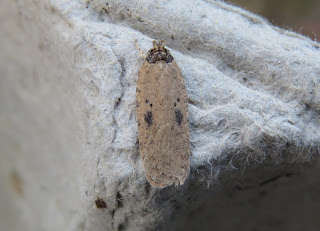Wind was much stronger today, and expectations were suitably low. 3 birds ringed in 6 hours seemed to bear this out. However, due perhaps to the lateness of the month, some species were battling their way through regardless. There were 2 sand martins headed north, 2 bramblings were present on observatory grounds and a cracking male ring ouzel was found by one of our members feeding on the lawn, leading to prolonged and great views for all. There were a few non passerines of interest, a tufted duck and common scoter heading north, and 4 bar-tailed godwits heading up the river.
Saturday 23rd April 2022
Ringing Recoveries
Song Thrush ringed Landguard 25th October 2021 was found dead 635 km away at Schwensbyer Weg, Sorup, Schleswig-Holstein, Germany on 18th April 2022. This bird will have been on autumn passage here, wintered we know not where, with it either succumbing on its spring migration or upon returning to its natal area. There are only 20 previous records of British ringed Song Thrush to Germany & this is a first for us.
Lesser Redpoll ringed Landguard 28th October 2020 retrapped 169 km away at Hazeley Heath, Hampshire 2nd April 2022. We have plenty of Redpoll recoveries to the north & south-east of us but this is a first to Hampshire.
Also several tits have been wandering around the docks to Trimley this spring -
Blue Tit ringed Landguard 19th September 2020 retrapped 5 km away at Trimley 2nd April 2022.
Blue Tit ringed Landguard 4th July 2021 retrapped 5 km away at Trimley 23rd March 2022.
Great Tit ringed Landguard 9th March 2022 retrapped 5 km away at Trimley 17th March 2022.
Friday 22nd April 2022
Moths were slightly more interesting, with a lovely specimen of a Swallow Prominent present. This species lives on poplars, of which the observatory has quite a few. Still a nice moth to look at, with a more than usually sensible name.
Ringed birds: 0
Thursday 21st April 2022
Hunt the migrant today produced 2 Wheatear, Chiffchaff, Willow Warbler & Whitethroat. Flying south 4 Oyk, 3 Goldfinch & north Grey Heron, Kittiwake & Swallow. 12 Sanderling and a Turnstone were on the beach early morning & a Black Red was singing from containers in the docks.
Moth trap returns still very poor although late morning onwards several day flyers come out to play in warm sheltered spots. Esperia sulphurella emerges around patches of dead wood.Wednesday 20th April 2022
Tuesday 19th April 2022
Insects are really getting into spring, apart from all the mining and other bees, more and more butterflies emerge by the day. New for the year was a speckled wood in the compound, with a supporting cast of small and green veined whites, peacocks and this comma. Like peacocks and small tortoisehells, this species hibernates through the British winter, but despite this, this individual is looking pretty fresh.
Winner of the best Latin name award was this micromoth Agonopterix subpropinquella. First for the year and a species that has a couple of colour forms, with this paler form being rarer at Landguard.
Monday 18th April 2022
What started out as a calm morning, ended up being quite exciting! Ringing was fairly good for the first few rounds, with the first lesser whitethroat of the year, and a lot of fat migrant warblers moving through.
However it was a mammal that first stole the show, a single bottlenose dolphin seen all morning moving up and down the coast. Dolphins are extremely rare in the southern north sea, and we presume this individual was lost. Interestingly, before I wrote this, a presumed minke whale was washed up further up the coast at Bawdsey, clearly conditions were right for some cetacean movement.
The momentum was snatched back late morning as a black kite moved south from Minsmere, tracked south by birders for an hour or so, and was seen distantly from the observatory by a few lucky individuals. At least two people DIDN'T see it, and they're not salty about that at all, I don't want my first British black kite to be a speck over Felixstowe docks . . . . .or at least that's what I'll be claiming from now on.
Moth traps produced the first V- pug of the year, though this was a little lost in the cetacean/raptor excitement (frustration for some) of the day.
Birds Ringed: Blackcap 7, Chiffchaff 2, Lesser Whitethroat 1, Linnet 2, Robin 1













